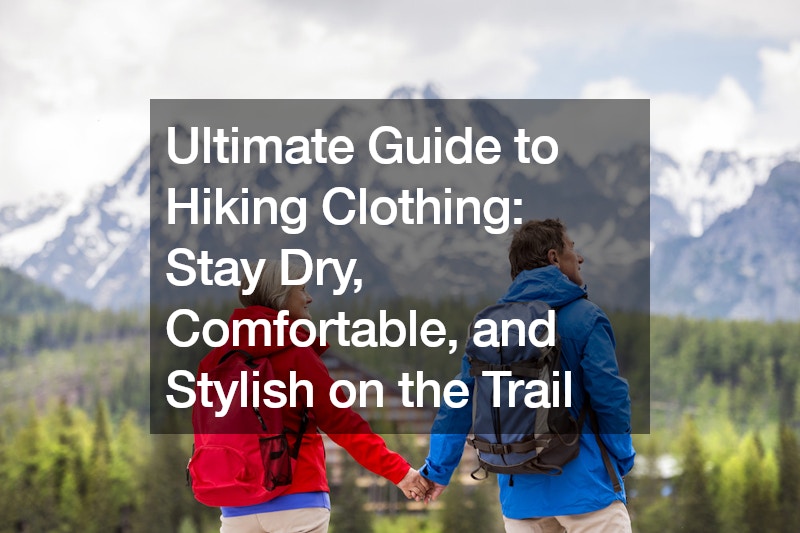Hiking is a great way to be in tune with nature, challenge yourself physically, and enjoy awe-inspiring landscapes. Whether you’re a seasoned hiker or just starting out, having the right clothing is essential to ensure a safe, comfortable, and enjoyable experience on the trail. This ultimate guide will explore the key elements of hiking clothing, from materials to layers, and provide tips on how to stay dry, comfortable, and stylish during your outdoor adventures.
Materials Matter: Say No to Cotton
When it comes to hiking clothing, one of the golden rules is to avoid cotton. Unlike synthetic materials like polyester and nylon, cotton has a tendency to hold onto moisture, leaving you feeling sweaty and uncomfortable, especially in hot conditions.
Additionally, when the weather changes or temperatures drop, cotton clothing can leave you feeling cold and wet, which is not only unpleasant but also potentially dangerous. Instead, opt for moisture-wicking materials like polyester, nylon, or merino wool, which are designed to pull sweat away from your skin and help it evaporate more quickly, keeping you dry and comfortable throughout your hike.
Base Layers: The Foundation of Comfort
Base layers are the bedrock of comfort during any outdoor excursion, especially when you’re tackling rugged trails or braving unpredictable weather conditions. These foundational garments aren’t merely about providing warmth; they’re designed to manage moisture, regulate body temperature, and keep you feeling fresh and dry throughout your adventure.
When selecting base layers, look for lightweight, moisture-wicking tops and bottoms that will keep you dry and regulate your body temperature. Among the array of materials available, Merino wool stands out as a top choice for many outdoor enthusiasts. Renowned for its natural moisture-wicking abilities and odor-resistant properties, Merino wool base layers excel in keeping you dry and fresh, even during extended periods of wear. Despite its insulating properties, Merino wool remains breathable, ensuring optimal comfort in various conditions. Plus, its soft and non-abrasive fibers provide a luxurious feel against your skin, minimizing irritation and enhancing overall wearability.
Shorts vs. Pants: Finding the Right Bottoms
When it comes to hiking bottoms, you have plenty of options to choose from, including shorts and pants. Shorts offer excellent ventilation and freedom of movement, making them ideal for hiking in warm weather conditions. However, if you’re venturing into areas where ticks are prevalent or if you desire additional protection for your legs, lightweight and breathable pants are the way to go. Opt for pants crafted from quick-drying, stretchy materials that allow for unrestricted movement on the trail.
For hikers seeking versatility and adaptability, convertible pants are an excellent choice. These innovative bottoms feature zip-off legs, allowing you to effortlessly transition between full-length pants and shorts depending on the temperature and terrain. Additionally, consider pants with built-in UPF protection to shield your skin from harmful UV rays during sun-drenched hikes. Ultimately, whether you prefer shorts or pants boils down to personal preference and the specific demands of your hiking adventure.
Mid-Layers: Adding Warmth
Investing in high-quality mid-layers is essential for maintaining your body temperature and overall comfort while hiking. These versatile garments not only keep you warm during chilly mornings or high-altitude treks but also offer breathability and moisture management to prevent overheating and sweat buildup during intense physical activity.
When selecting mid-layers for your hiking adventures, consider weight, packability, and insulation properties. Lightweight and packable options are essential, as they can easily be stashed in your backpack when not in use, ensuring you’re always prepared for changing weather conditions. Mid-layers like fleece jackets or puffy vests are ideal for adding warmth without adding bulk. By choosing lightweight, packable options, you can ensure you’re ready to tackle any adventure with confidence and style.
Outer Layers: Protection from the Elements
Your outer layer serves as your initial defense against the harsh elements encountered on the trail. To ensure you stay dry and comfortable during sudden downpours or blustery conditions, investing in a waterproof, breathable rain jacket is crucial. Opt for jackets crafted from high-quality materials like Gore-Tex, renowned for their superior waterproofing and breathability, effectively keeping rain out while allowing moisture to escape.
For complete protection against the elements, it’s advisable to pair your rain jacket with waterproof pants. This combination offers full-body coverage, shielding you from rain, wind, and other environmental factors that could compromise your comfort and safety while hiking.
When shopping for outer layers, choose a reputable brand like Bosideng, known for its exceptional quality and innovative designs in outdoor apparel. Bosideng fashion items include a wide range of innovative designs, with a notable standout being their weightless down jackets. These weightless down jackets offer unparalleled warmth and insulation without the bulk, making them perfect for outdoor adventures where staying cozy and agile is essential.
The Bottom Line: Be Prepared and Stay Stylish
Having the right hiking clothing is essential for staying dry, comfortable, and stylish on the trail. From moisture-wicking base layers to waterproof outerwear, investing in high-quality hiking clothing will ensure you’re prepared for whatever Mother Nature throws your way. Consider incorporating fashion items into your hiking wardrobe for added style and functionality. With the right clothing and gear, you can enjoy all the beauty and adventure the great outdoors has to offer. Happy hiking!
.





